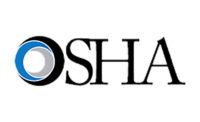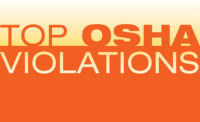OSHA announced its preliminary Top 10 most frequently cited workplace safety standards for fiscal year 2020. As is usually the case, the Top 10 violations didn’t change from FY 2019, they just swapped numbers.
Ladders (1926.1053) climbed to a top-five spot, and Respiratory Protection (1910.134) rose to the third rank from fifth. Additionally, the data show that Fall Protection – General Requirements (1926.501) is OSHA’s most frequently cited standard for the 10th successive fiscal year.
OSHA suggests that employers use the Top 10 list to identify issues in their workplaces and a good starting point on the path to correcting hazards. Many of the standards listed in the Top 10 are related to training, so it’s important to take a look at training practices and consider ways to improve training programs.
“In a year that was defined by the ongoing pandemic, workplace safety became more important than ever,” said Lorraine M. Martin, NSC president and CEO. “The OSHA Top 10 list reminds us why we must continue to focus on persistent safety risks as we navigate new challenges. These data help us pinpoint areas where we can improve so we can better prioritize workplace safety in the future world of work.”
The Top 10 for FY 2020
- Fall Protection – General Requirements (1926.501): 5,424 violations
- Hazard Communication (1910.1200): 3,199
- Respiratory Protection (1910.134): 2,649
- Scaffolding (1926.451): 2,538
- Ladders (1926.1053): 2,129
- Lockout/Tagout (1910.147): 2,065
- Powered Industrial Trucks (1910.178): 1,932
- Fall Protection – Training Requirements (1926.503): 1,621
- Personal Protective and Life Saving Equipment – Eye and Face Protection (1926.102): 1,369
- Machine Guarding (1910.212): 1,313
Another COVID vaccine approved
Johnson & Johnson’s COVID vaccine was recently approved by the CDC and the FDA, which means more Americans will be able to get vaccinated.
Centers for Disease Control and Prevention vaccine advisers voted at the end of February to recommend the Johnson & Johnson Covid-19 vaccine for the US, and CDC Director Dr. Rochelle Walensky almost immediately signed off on the recommendation. It is the first of the three authorized Covid-19 vaccines that comes in a single dose.
“The Janssen vaccine has been shown to be safe and effective in preventing severe COVID-19 illness, hospitalization, and death,” Walensky said in a statement.
“This vaccine is also another important tool in our toolbox to equitably vaccinate as many people as possible, as quickly as possible,” she said.
While this is great news, a recent study by the Society for Human Resource Management (SHRM) found that there are still a significant number of workers say they are unlikely to get vaccinated.
If large numbers of workers remain fearful of the vaccine, it could delay business from returning to normal operations.
However, the study did reveal that a substantial number of workers believe the COVID-19 vaccine should be mandatory for everyone who is able to receive it, which could create conflicts with colleagues who won't get vaccinated. Many companies are encouraging their employees to get the vaccine, but they say they are not going to require workers to get vaccinated before they return to work.
SHRM also found that:
- 60 percent of workers will probably or definitely get the vaccine once it becomes available to them.
- Nearly a quarter (24 percent) of employees who are not planning to get vaccinated would change their minds if their employer offered incentives such as cash bonuses or stipends, paid time off (PTO) or gift cards.
- 12 percent of employees would be willing to get vaccinated only if they might otherwise lose their job.










